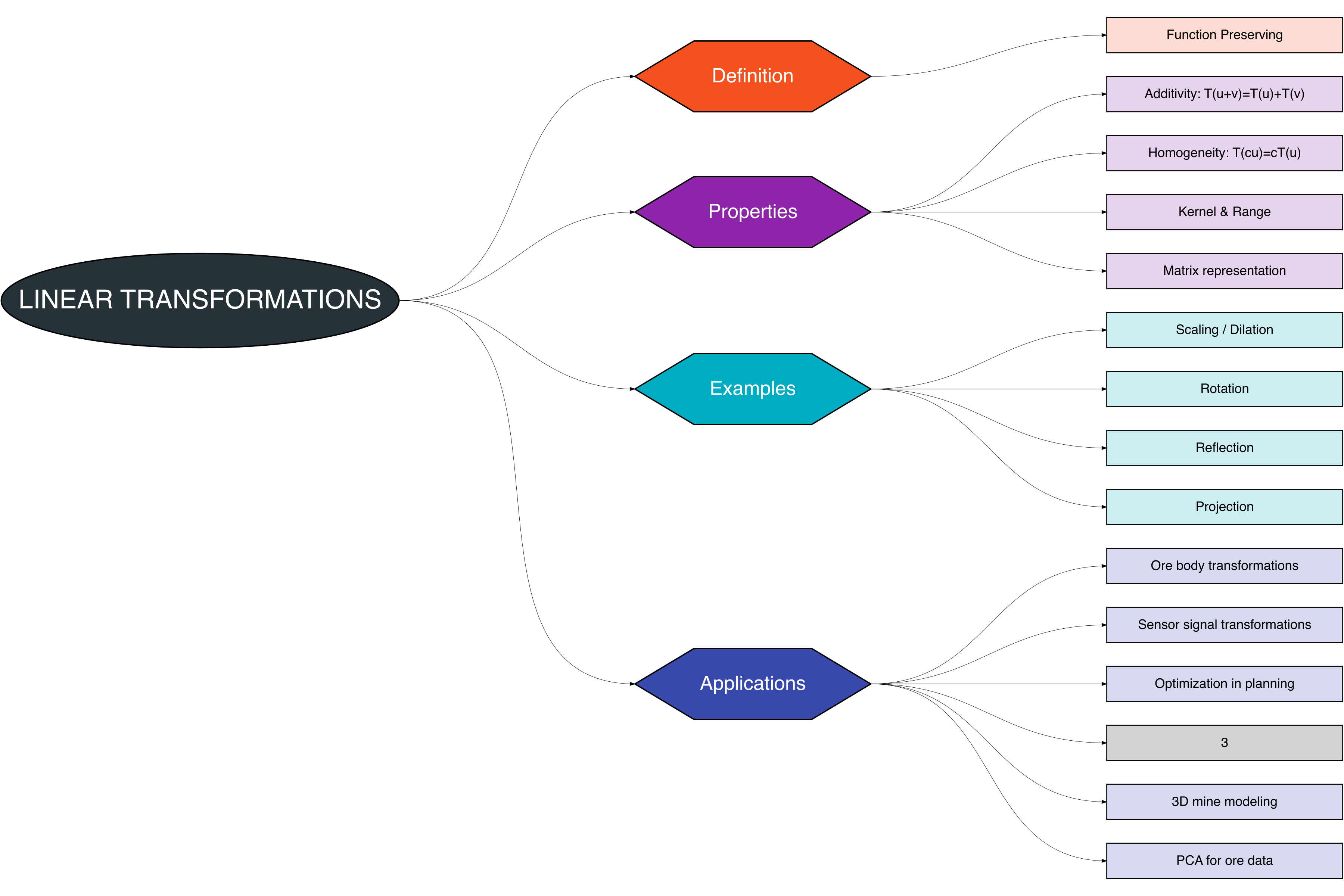
8 Linear Transformations
In this chapter, we explore the concept of linear transformations in vector and inner product spaces, along with their fundamental properties. A mind map provides a structured overview of the key topics discussed:

Linear transformations are functions between vector spaces that preserve vector addition and scalar multiplication. They provide a framework to map vectors from one space to another while maintaining the structure of the space.
In the context of mining engineering:
- Ore Body Mapping & Alignment: Linear transformations can represent rotations, scaling, and translations of ore bodies to align geological survey data from multiple sources, ensuring consistency in 3D models chiles2012?.
- Geotechnical Sensor Data Processing: Measurements from strain gauges, accelerometers, or seismic sensors can be linearly transformed to extract independent components, filter noise, and improve signal interpretation [1].
- Production & Resource Planning: Extraction schedules, equipment deployment, and workforce assignments can be modeled as linear transformations to optimize operations under given constraints meyer2000?.
- 3D Mine Design & Modeling: Tunnel layouts, boreholes, and ore body geometries can be transformed in \(\mathbb{R}^3\) to enable visualization, simulation, and coordinate system adjustments for mine planning rubinstein2016?.
- Dimensionality Reduction of Ore Grade Data: Linear transformations such as Principal Component Analysis (PCA) identify orthogonal directions that maximize variance, helping to simplify datasets, reduce computational complexity, and enhance geostatistical modeling [1].
8.1 Definition
A transformation \(T: V \to W\) between vector spaces \(V\) and \(W\) is linear if, for all \(u, v \in V\) and scalars \(c \in \mathbb{R}\):
\[ T(u + v) = T(u) + T(v), \quad T(cu) = c \, T(u) \]
Key concepts:
Kernel (Null Space):
\[ \text{ker}(T) = \{ v \in V : T(v) = 0 \} \]Range (Image):
\[ \text{range}(T) = \{ T(v) : v \in V \} \]Matrix Representation:
Every linear transformation can be represented by a matrix relative to chosen bases, enabling computation and composition.
8.2 Properties
Additivity:
\[ T(u+v) = T(u) + T(v) \]Homogeneity (Scalar Multiplication):
\[ T(c u) = c \, T(u) \]Kernel & Range: Describe the null space and image of \(T\).
Matrix Representation: Enables computation, composition, and application of transformations.
8.3 Examples
Scaling / Dilation:
\[ T(x) = k x \]
Stretches or shrinks vectors by a factor \(k\).Rotation:
Rotates vectors around an origin in \(\mathbb{R}^2\) or \(\mathbb{R}^3\).Reflection:
Reflects vectors across a line, plane, or hyperplane.Projection:
Projects vectors onto a subspace.
8.4 Applications
Ore Body Transformations:
Linear transformations can adjust survey data for modeling and alignment of ore bodies chiles2012?.Sensor Signal Analysis:
Transform signals from monitoring equipment for feature extraction or filtering, enabling better interpretation of geotechnical or seismic data [1].Optimization of Resources:
Apply linear mappings to planning constraints and allocation strategies for workforce, equipment, and materials meyer2000?.3D Mine Modeling:
Transform mine coordinates for visualization, simulation, and planning in \(\mathbb{R}^3\) rubinstein2016?.PCA Transformations:
Reduce dimensionality of ore grade datasets while preserving key variance, aiding geostatistical modeling and predictive analytics [1].
